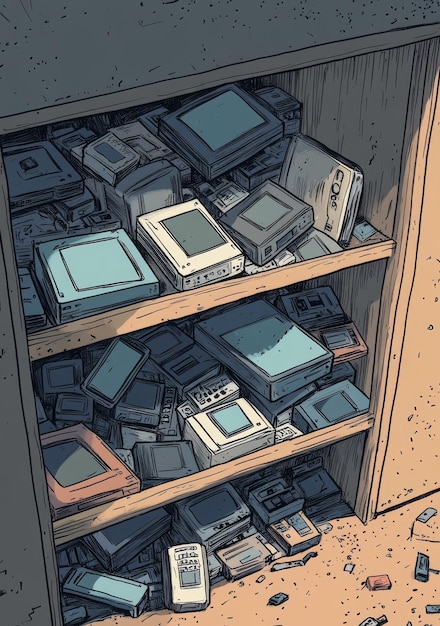Cloud Gaming on Consoles: Ditching Discs for Good in 2025?

Cloud gaming on consoles aims to offer a disc-free future, by streaming games directly to devices, raising the question of whether it’s a reliable alternative to physical copies by 2025, considering factors like internet speed, game availability, and cost.
Is cloud gaming on consoles a viable alternative to physical discs in 2025? As technology advances and internet speeds improve, the prospect of streaming games directly to our consoles becomes increasingly appealing, offering a potentially disc-free future.
The Rise of Cloud Gaming on Consoles
Cloud gaming has been gaining traction in recent years as a way to access and play video games without the need for physical hardware. Consoles, traditionally reliant on discs or digital downloads, are now entering the cloud gaming arena. This section explores the evolution and current state of cloud gaming on consoles.
What is Cloud Gaming?
Cloud gaming, at its core, is streaming video games over the internet, similar to how you might stream a movie or TV show. The game runs on a remote server, and the video and audio are transmitted to your device.
Console Integration
Major console manufacturers like Microsoft (Xbox Cloud Gaming) and Sony (PlayStation Plus Premium) have integrated cloud gaming into their services. This allows gamers to play a variety of titles without needing to download or install them.

- Accessibility: Cloud gaming can make gaming more accessible to those who may not be able to afford the latest consoles or high-end PCs.
- Convenience: No need to worry about physical discs or long download times; games are instantly accessible.
- Cross-Platform Play: Some cloud gaming services allow you to play games on various devices, including consoles, PCs, and mobile devices.
The integration of cloud gaming into consoles represents a significant shift in how games are accessed and played. It offers numerous benefits, including accessibility, convenience, and cross-platform play, making it an attractive option for many gamers.
Advantages of Cloud Gaming Over Physical Discs
Cloud gaming brings several potential advantages, ranging from pure convenience to cost implications and environmental benefits. Let’s take a closer look at the details.
Space Saving
One of the most immediate benefits of cloud gaming is that it eliminates the need for physical game copies. Digital downloads reduce the need for physical media, but still require storage space.
Instant Access
With cloud gaming, games are available to play almost instantly. There is no more waiting for games to be downloaded or installed or shuffling discs; you select a game and start playing.

- Reduced Carbon Footprint: Fewer physical discs mean less manufacturing, transportation, and waste.
- Lower Upfront Costs?: Some cloud gaming services may offer subscription models that could potentially be more affordable than buying individual games or even entire consoles. This is still not entirely clear.
- Game Preservation: Depending on how services are structured, cloud gaming might offer a way to preserve older games that are no longer available on physical media.
Cloud gaming’s advantages over physical discs are compelling. The environmental impact, potential cost savings, and accessibility all point to a future where streaming games becomes the norm, offering convenience and variety without the need for physical media.
Disadvantages and Limitations of Cloud Gaming
Cloud gaming is not without its drawbacks. While it offers several advantages, there are limitations that need to be considered. It’s essential to understand these downsides to get a clear picture of whether cloud gaming is a better alternative.
Internet Dependency
Reliable, high-speed internet is paramount for cloud gaming to be useful. Without a stable connection, players may experience lag, stuttering, or even disconnections.
Latency Issues
Even with a good internet connection, latency can still be a problem. The delay between input and action on the screen can be frustrating, especially in fast-paced games.
Content Availability
Not all games are available on cloud gaming services, and content libraries can vary significantly between services. You may not be able to play your favorite games through the cloud, or they might be only available for a limited time.
The limitations of cloud gaming are considerable. Addressing these issues will be crucial for cloud gaming to become a truly viable alternative to physical discs. Overcoming these challenges is critical to the widespread adoption of cloud gaming on consoles in the future.
Infrastructure and Technological Requirements
The feasibility of cloud gaming relies heavily on the underlying infrastructure and technological advancements. This section delves into the requirements necessary for a seamless cloud gaming experience on consoles.
Internet Speed and Stability
A fast and stable internet connection is the cornerstone of cloud gaming. Most services recommend a minimum download speed of 25 Mbps, but faster speeds are generally required for high-resolution gaming with minimal lag.
Server Locations
The proximity of gaming servers to the player is another critical factor. The closer the server, the lower the latency. Services with a global network of servers will provide a better experience for players worldwide.
Advancements in Compression and Streaming Technology
Technological advancements in video compression, streaming protocols, and edge computing are continually improving the cloud gaming experience. These advancements help reduce latency and improve image quality.
- 5G and Wi-Fi 6: The rollout of 5G networks and Wi-Fi 6 technology will provide faster and more stable wireless connections, making cloud gaming more accessible.
- Edge Computing: By bringing computing resources closer to the user, edge computing can significantly reduce latency.
- Improved Codecs: Advancements in video codecs, such as AV1, can improve image quality while reducing bandwidth usage.
The infrastructure and technological requirements for cloud gaming on consoles are substantial. Continued investments and innovations in these areas are essential for cloud gaming to reach its full potential and become a viable alternative to physical discs.
The Console Manufacturers’ Perspective
The big console manufacturers like Microsoft and Sony are heavily invested in cloud gaming. This section explores their strategies and future plans.
Microsoft’s Xbox Cloud Gaming
Microsoft’s Xbox Cloud Gaming, also known as xCloud, is part of the Xbox Game Pass Ultimate subscription. It allows subscribers to stream a wide range of Xbox games to their consoles, PCs, and mobile devices.
Sony’s PlayStation Plus Premium
Sony’s PlayStation Plus Premium includes cloud gaming as part of its subscription. Subscribers can stream PlayStation games to their consoles and PCs.
As console manufacturers continue to invest in cloud gaming, we can expect to see improvements in game availability, streaming technology, and overall user experience. This will contribute significantly to whether cloud gaming becomes a standard way to play games on consoles.
Potential Future Developments and Predictions for 2025
Looking ahead to 2025, it’s possible to make some predictions about where cloud gaming will stand as an alternative to physical media. The factors will be advancements in supporting technologies and the priorities within the gaming industry itself.
Improved Infrastructure
As 5G networks become more widespread and internet infrastructure improves, cloud gaming will become more accessible to a larger audience. Lower latency and faster speeds will enhance the overall gaming experience.
Expanded Game Libraries
Cloud gaming services will likely expand their game libraries, offering a wider variety of titles. This will make cloud gaming more appealing to a broader range of gamers.
Enhanced User Experience
Cloud gaming services will continue to refine their user interfaces, making it easier for players to find and play games. Integration with console operating systems will also improve.
- AI and Machine Learning: AI and machine learning could be used to optimize streaming quality based on network conditions and predict player behavior.
- Virtual Reality (VR) Integration: Cloud gaming may enable VR experiences on consoles without requiring high-end hardware.
- Cross-Platform Compatibility: Cloud gaming could further bridge the gap between consoles, PCs, and mobile devices, allowing players to seamlessly switch between platforms.
By 2025, cloud gaming on consoles will likely be a more viable alternative to physical discs for many gamers. As technology advances and services improve, cloud gaming will become an increasingly attractive option for accessing and playing video games.
| Key Aspect | Brief Description |
|---|---|
| 🎮 Convenience | Instant access to games without downloads or physical media. |
| ☁️ Infrastructure | Reliant on fast, stable internet; server proximity matters. |
| 💰 Cost | Subscription models may offer cost benefits over buying individual games. |
| 🌐 Availability | Game selection may vary; not all titles might be available. |
Frequently Asked Questions
▼
A stable internet connection with a minimum download speed of 25 Mbps is generally recommended for smooth cloud gaming. Higher speeds may be needed for higher resolutions.
▼
Not necessarily. The availability of games varies between cloud gaming services, and some titles may not be available for streaming.
▼
It depends. Subscription models may offer cost benefits, but it’s essential to compare the cost of the subscription to the price of individual games.
▼
Latency, or input lag, can negatively impact the gaming experience. Lower latency is essential for fast-paced and competitive games to feel responsive.
▼
While cloud gaming is growing, physical discs are unlikely to disappear entirely by 2025. Many gamers still prefer the tangible ownership and resale value of physical copies.
Conclusion
In conclusion, whether cloud gaming on consoles will be an entirely viable alternative to physical discs by 2025 depends on multiple factors, including technological advancements, infrastructure improvements, and the gaming industry’s broader trends. While challenges remain, the potential benefits of convenience, accessibility, and cost savings are compelling enough to suggest that cloud gaming will play an increasingly important role in the console gaming experience.





